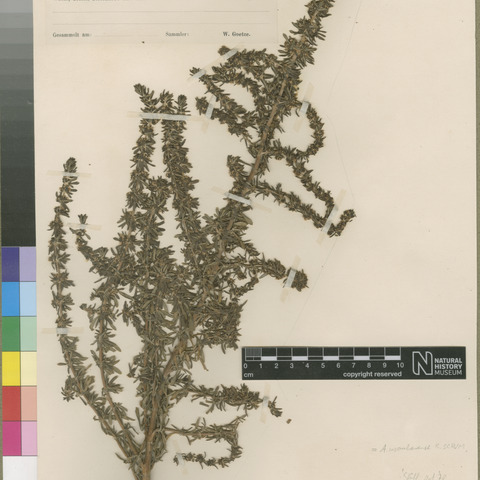Leaves in whorls of 3 or, less often, decussate, pseudo-verticillate; blades (2)3–10(15) x 0.5–1.5(2) mm. (on new growth occasionally to 20 x 3 mm.), narrowly obovate, oblanceolate, oblong-elliptic, lanceolate to ± linear, mostly glabrous; margins often (strongly) revolute; petioles subobsolete; stipular sheath shortly hairy, with 3–7(8) setae, the longest 1–4.1 mm. long.
Flowers subsessile, in clusters of many at nodes, inflorescences rather dimorphic, in female often quite contracted, dense, ± cylindrical inflorescence zones; corolla 4-merous (very seldom 5-merous), greenish to creamy yellow, often dark purplish-red or-brown ringed outside, glabrous or with a few odd hairs.
Fruit reddish-brown, shiny or greyish-brown; mericarps 1.2–2.2(2.4) x 0.7–1 mm., ± obovate, oblong to elliptic, mostly glabrous, with 2 ± triangular calyx lobes 0.2–0.6 x 0.3–0.4 mm., one often larger than the other.
Male: tube 0.7–1.6 mm. long, funnel-shaped, lobes 1.4–2.4(2.7) x 0.6–1(1.4) mm.; anthers (0.7)1–1.7 mm. long; small rudimentary ovary mostly with 4 small calyx lobes, occasionally also rudimentary stigmas present.
Female: tube 0.3–0.7 mm. long, lobes 0.2–0.7 x 0.1–0.3 mm.; style 0–0.5 mm. long; stigmas 3–6.1 mm. long; ovary 0.7–0.8 x 0.5–0.6 mm., with 4 subequal or 2 longer and 2 shorter calyx lobes.
Stems mostly much-branched above, branches ± regular, arising in threes (less commonly paired), often ascending to ± erect, usually shortly hairy, ± densely leafy.
Dioecious shrub, single-stemmed, erect, 1–3 m. tall.

